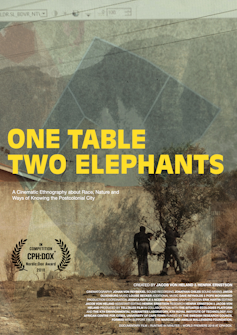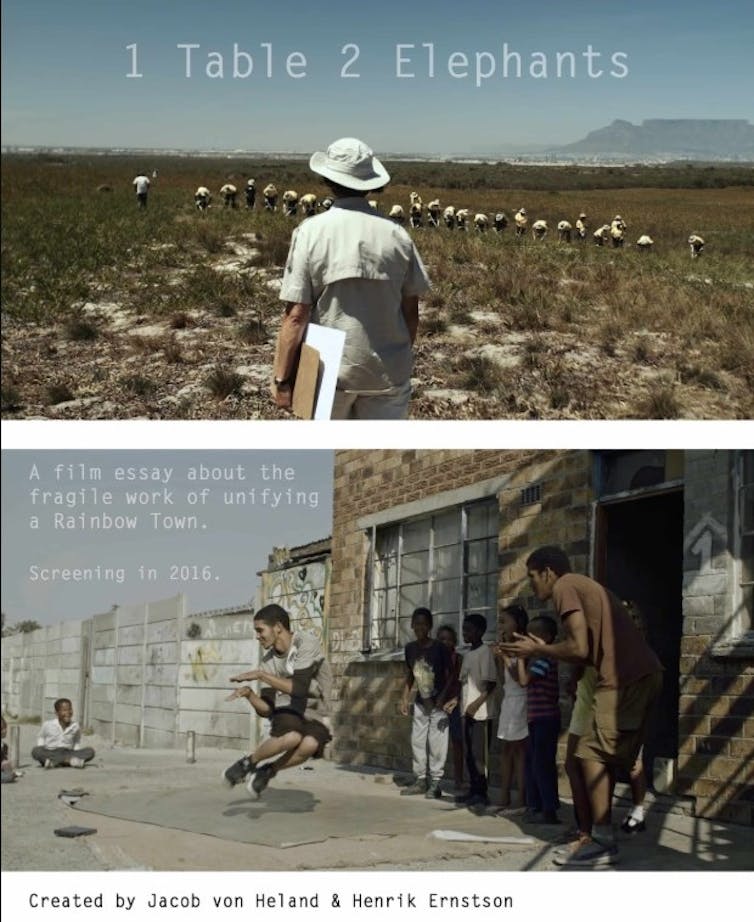Asma Mehan, Universidade do Porto
Academics have increasingly used video and other electronic methods to collect data and capture reflections from participants. But, until recently, it’s been less common to use film as way of disseminating the results of research. That’s beginning to change.
Film can be a powerful way to share research findings with a broad audience. This is particularly true when academics are combining) the traditions of ethnography, documentary filmmaking, and storytelling.
Film and cinema are increasingly being used in environmental humanities to complement – or challenge – text-based research. The filmmakers in the arts, sciences and humanities see potential in using the moving images within political philosophy, environmental politics, postcolonial studies, human geography, urban ecology, postcolonial studies, design and literature.
An example of this is the film One Table Two Elephants. It is a cinematic ethnography created by two Swedish researchers and filmmakers Jacob von Heland and Henrik Ernstson. Based on years of research in Cape Town, it was filmed in 2015 as part of a longer-term research and film-project . The documentary deals with race, nature and knowledge politics in Cape Town as part of the ways of knowing urban ecologies research project.
Focusing on the global south, this project sought to critically examine the social, cultural and political dimensions of how resources are managed in rapidly growing urban spaces. It set out to answer and provoke debates about questions of sustainability and equality, including questions about identity and power in the context of a postcolonial city. The creators tried to develop and define visual humanities as a rich register to speak eloquently, forcefully and with texture into environmental questions.
The film is part of a wider project to use film as research in challenging and complementing pen and paper. Following this perspective – and based on the explorative idea to treat film-as-research/research-as-film – the filmmakers use cinematic and audio-visual registers to texture people’s understanding of Cape Town. These range from intimate relations to structural issues. The aim is to move the audience beyond simplistic understandings while providing possibilities to translate what is happening to wider conversations about race, nature, and the city in other places of the world.
The film has been nominated for several prizes and screened at film festivals in Copenhagen, Cape Town, Tirana, Nijmegen and Stockholm. It became an amazing learning space for the researchers and highly productive for especially the younger scholars and students that have been involved.
The film
Entering the city through its plants and wetlands, the many-layered, painful and liberating history of the city emerges as the film follows how biologists, hip hoppers, and wetland activists each search for ways to craft symbols of unity and cohesion.

The film starts by following black, hip hop break dancers who are trying to bring in their own cultural roots into modern dancing techniques. It also follows conservation efforts being pursued by white residents of the city.
The documentary is directed towards the general public as well as students and scholars. It brings texture to understanding a city like Cape Town. At the same time it provides possibilities to translate what it’s recording into conversations about other cities and surroundings.
Situated and grounded in lived experiences across a range of groups, this film follows different ways of knowing. It tries to be a vehicle toward difficult yet urgently needed conversations about how race, nature and the city are intertwined in South Africa’s postcolonial world, where history is ever present in subtle and direct ways.
The film is unusual in a number of ways. The material is rich and textured. It is edited without a voice over. This enables it to convey multiple interrelated histories across the city.
The film provides possibilities for non-expert as well as experts to reflect on and deliberate over how a city and its environments can be known.

Lessons learnt
The film doesn’t attempt to formulate a coherent theory. Rather, it should be treated as an intellectual investigation that opens up the space to unknown territory – the inter-relationship between the creators of the movie and its subject matter. In this way, it can open the discussion and sketch possible lines of future research.
By developing in-depth studies in Cape Town, South Africa, a rapidly growing city shaped by its colonial and apartheid past and highly unequal, culturally diverse and grappling with resource management challenges, the film aims to contrast the local knowledge with the dominant western one. In this way, it explores the politics of urban environmental knowledge in postcolonial cities. It tries to transmit the “knowledge” that is already produced towards a larger audience.
One Table Two Elephants (Documentary film, 84 min, 2018), created by Jacob von Heland and Henrik Ernstson.![]()
Asma Mehan, Postdoctoral research associate, Universidade do Porto
This article is republished from The Conversation under a Creative Commons license. Read the original article.


